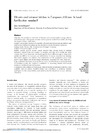Identificador persistente para citar o vincular este elemento:
https://accedacris.ulpgc.es/jspui/handle/10553/44865
| Campo DC | Valor | idioma |
|---|---|---|
| dc.contributor.author | Serra-Majem, L. | en_US |
| dc.date.accessioned | 2018-11-22T03:11:27Z | - |
| dc.date.available | 2018-11-22T03:11:27Z | - |
| dc.date.issued | 2001 | en_US |
| dc.identifier.issn | 1368-9800 | en_US |
| dc.identifier.uri | https://accedacris.ulpgc.es/handle/10553/44865 | - |
| dc.description.abstract | Objective: To provide an overview of vitamin and mineral intakes among children and adolescents in European countries and to present results from studies showing the impact of food fortification. Design: Comparative analysis of a number of nutritional studies among children and adolescents performed during the last decade in certain European countries. Setting: Spain, France, UK, North Ireland, Portugal, Germany. Subjects: Europeans aged 6 to 18. Results: Dietary surveys across Europe showed that varying levels of nutrient adequacy existed from one country to another, and that even within the same country, there were important nutritional gaps between different regions. In general, studies are difficult to compare, and information for many countries was missing. The results suggest that children and adolescents are the population group most likely to have higher risk of nutritional deficiencies, particularly for iron, vitamins C, E, B6 and folates. In France, Ireland, UK and Spain, food fortification, and particularly of breakfast cereals, has positively contributed to increasing vitamin and mineral intakes in childhood and adolescence. Conclusions: Information on vitamin and mineral intakes in European children is less available than in adults. Fortified foods may contribute to reducing nutrient inadequacy in European children and adolescents, but should not replace nutrition education. | en_US |
| dc.language | eng | en_US |
| dc.relation.ispartof | Public Health Nutrition | en_US |
| dc.source | Public Health Nutrition [ISSN 1368-9800], v. 4, p. 101-107 | en_US |
| dc.subject | 32 Ciencias médicas | en_US |
| dc.subject | 3206 Ciencias de la nutrición | en_US |
| dc.subject.other | Children | en_US |
| dc.subject.other | Adolescent | en_US |
| dc.subject.other | Dietary intake | en_US |
| dc.subject.other | Nutrition education | en_US |
| dc.subject.other | Food fortification | en_US |
| dc.subject.other | Europe | en_US |
| dc.title | Vitamin and mineral intakes in European children. Is food fortification needed? | en_US |
| dc.type | info:eu-repo/semantics/review | en_US |
| dc.type | Article | en_US |
| dc.identifier.doi | 10.1079/PHN2000104 | - |
| dc.identifier.scopus | 0035079054 | - |
| dc.contributor.authorscopusid | 35596972100 | - |
| dc.description.lastpage | 107 | en_US |
| dc.description.firstpage | 101 | en_US |
| dc.relation.volume | 4 | en_US |
| dc.investigacion | Ciencias de la Salud | en_US |
| dc.type2 | Reseña | en_US |
| dc.description.numberofpages | 8 | en_US |
| dc.utils.revision | Sí | en_US |
| dc.date.coverdate | Enero 2001 | en_US |
| dc.identifier.ulpgc | Sí | en_US |
| dc.contributor.buulpgc | BU-MED | en_US |
| dc.description.scie | SCIE | |
| item.grantfulltext | open | - |
| item.fulltext | Con texto completo | - |
| crisitem.author.dept | GIR IUIBS: Nutrición | - |
| crisitem.author.dept | IU de Investigaciones Biomédicas y Sanitarias | - |
| crisitem.author.dept | Departamento de Ciencias Clínicas | - |
| crisitem.author.orcid | 0000-0002-9658-9061 | - |
| crisitem.author.parentorg | IU de Investigaciones Biomédicas y Sanitarias | - |
| crisitem.author.fullName | Serra Majem, Luis | - |
| Colección: | Reseña | |
Citas SCOPUSTM
59
actualizado el 08-jun-2025
Visitas
79
actualizado el 11-ene-2025
Descargas
178
actualizado el 11-ene-2025
Google ScholarTM
Verifica
Altmetric
Comparte
Exporta metadatos
Los elementos en ULPGC accedaCRIS están protegidos por derechos de autor con todos los derechos reservados, a menos que se indique lo contrario.
